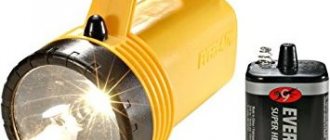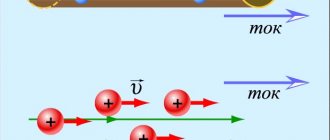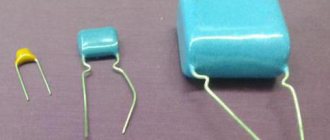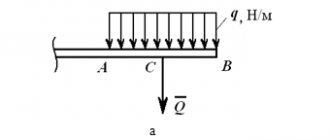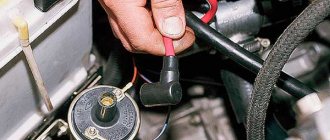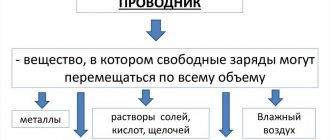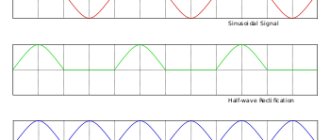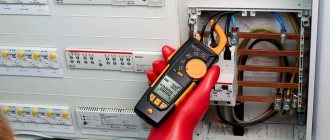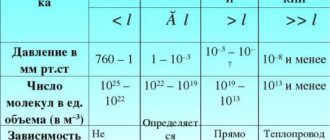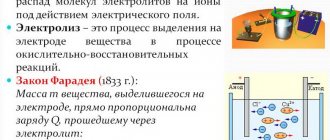Definition
Electric current is the directed movement of charge carriers - this is a standard formulation from a physics textbook. In turn, charge carriers are called certain particles of matter. They may be:
- Electrons are negative charge carriers.
- Ions are positive charge carriers.
But where do charge carriers come from? To answer this question, you need to remember basic knowledge about the structure of matter. Everything that surrounds us is matter; it consists of molecules, its smallest particles. Molecules are made up of atoms. An atom consists of a nucleus around which electrons move in given orbits. Molecules also move randomly. The movement and structure of each of these particles depends on the substance itself and the influence of the environment on it, such as temperature, stress, and others.
An ion is an atom whose ratio of electrons and protons has changed. If the atom is initially neutral, then the ions, in turn, are divided into:
- Anion is a positive ion of an atom that has lost electrons.
- Cations are an atom with “extra” electrons attached to the atom.
The unit of current measurement is Ampere, according to Ohm's law it is calculated by the formula:
I=U/R,
where U is voltage, [V], and R is resistance, [Ohm].
Or directly proportional to the amount of charge transferred per unit time:
I=Q/t,
where Q – charge, [C], t – time, [s].
Power
Electrical power is a physical quantity that determines the rate of electricity conversion. For example, you have heard more than once: “a light bulb is so many watts.” This is the power consumed by the light bulb per unit of time during operation, i.e. converting one type of energy into another at a certain speed.
Sources of electricity, such as generators, are also characterized by power, but already generated per unit of time.
The unit of power measurement is Watt (denoted by W
or
W
).
In formulas and calculations, power is denoted by the
letter
P. For alternating current circuits, the term is used Apparent power , the unit of measurement is Volt-ampere ( VA
or
V A
) , denoted by the letter
S.
And finally about the Electric Circuit . This circuit is a certain set of electrical components capable of conducting electric current and interconnected accordingly.
What we see in this image is a basic electrical device (flashlight). Under voltage U
(B) a source of electricity (battery), through conductors and other components with different resistances
R
(Ohm), an electric current
I
(A) flows from plus to minus, causing the light bulb to glow with power
P
(W). Do not pay attention to the brightness of the lamp, this is due to poor pressure and low water flow of the batteries.
The flashlight shown in the photo is assembled on the basis of the “Znatok” construction set. This construction set allows a child to learn the basics of electronics and the operating principles of electronic components in a playful way. Supplied in the form of sets with different numbers of patterns and different levels of complexity.
Conditions for the existence of electric current
We figured out what electric current is, now let's talk about how to ensure its flow. For electric current to flow, two conditions must be met:
- Presence of free charge carriers.
- Electric field.
The first condition for the existence and flow of electricity depends on the substance in which the current flows (or does not flow), as well as its state. The second condition is also feasible: for the existence of an electric field, the presence of different potentials is required, between which there is a medium in which charge carriers will flow.
Let us remind you: Voltage, EMF is the potential difference. It follows that in order to fulfill the conditions for the existence of current - the presence of an electric field and electric current, voltage is needed. These can be the plates of a charged capacitor, a galvanic element, or an EMF generated under the influence of a magnetic field (generator).
We have figured out how it arises, let’s talk about where it is directed. Current, mainly in our usual use, moves in conductors (electrical wiring in an apartment, incandescent light bulbs) or in semiconductors (LEDs, the processor of your smartphone and other electronics), less often in gases (fluorescent lamps).
So, the main charge carriers in most cases are electrons; they move from minus (a point with a negative potential) to a plus (a point with a positive potential, you will learn more about this below).
But an interesting fact is that the direction of current movement was taken to be the movement of positive charges - from plus to minus. Although in fact everything happens the other way around. The fact is that the decision on the direction of the current was made before studying its nature, and also before it was determined how the current flows and exists.
Electric charge in motion
What are the conditions for the existence of electric current? It can take the form of a sudden discharge of static electricity, such as lightning or a spark from friction with woolen fabric. More often, however, when we talk about electric current, we're talking about a more controlled form of electricity that makes lights burn and appliances work. Most of the electrical charge is carried by negative electrons and positive protons within an atom. However, the latter are mainly immobilized inside atomic nuclei, so the work of transferring charge from one place to another is done by electrons.
Electrons in a conducting material such as a metal are largely free to move from one atom to another along their conduction bands, which are the highest electron orbits. Sufficient electromotive force or voltage creates a charge imbalance that can cause electrons to flow through a conductor in the form of an electric current.
If we draw an analogy with water, then take, for example, a pipe. When we open the valve at one end to allow water to flow into the pipe, we do not have to wait for that water to make its way all the way to the end. We get water at the other end almost instantly because the incoming water pushes the water that is already in the pipe. This is what happens when there is an electric current in a wire.
Electric current in different environments
We have already mentioned that in different environments, electric current can differ in the type of charge carriers. Media can be divided according to the nature of their conductivity (in descending order of conductivity):
- Conductor (metals).
- Semiconductor (silicon, germanium, gallium arsenide, etc.).
- Dielectric (vacuum, air, distilled water).
In metals
Metals contain free charge carriers, they are sometimes called "electric gas". Where do free charge carriers come from? The fact is that metal, like any substance, consists of atoms. Atoms move or vibrate one way or another. The higher the temperature of the metal, the stronger this movement. At the same time, the atoms themselves generally remain in their places, actually forming the structure of the metal.
In the electron shells of an atom there are usually several electrons whose connection with the nucleus is rather weak. Under the influence of temperatures, chemical reactions and the interaction of impurities, which are in any case in the metal, electrons are torn away from their atoms, and positively charged ions are formed. The detached electrons are called free and move chaotically.
If they are affected by an electric field, for example, if you connect a battery to a piece of metal, the chaotic movement of electrons will become orderly. Electrons from a point at which a negative potential is connected (the cathode of a galvanic cell, for example) will begin to move towards a point with a positive potential.
In semiconductors
Semiconductors are materials in which in the normal state there are no free charge carriers. They are in the so-called forbidden zone. But if external forces are applied, such as an electric field, heat, various radiations (light, radiation, etc.), they overcome the band gap and move into the free zone or conduction band. Electrons break away from their atoms and become free, forming ions - positive charge carriers.
Positive carriers in semiconductors are called holes.
If you simply transfer energy to a semiconductor, for example, heat it, a chaotic movement of charge carriers will begin. But if we are talking about semiconductor elements, such as a diode or transistor, then an EMF will arise at the opposite ends of the crystal (a metallized layer is applied to them and the leads are soldered), but this does not relate to the topic of today’s article.
If you apply an EMF source to a semiconductor, then the charge carriers will also move to the conduction band, and their directional movement will also begin - holes will go in the direction with a lower electric potential, and electrons - in the direction with a higher one.
In vacuum and gas
A vacuum is a medium with a complete (ideal case) absence of gases or a minimized (in reality) amount of gas. Since there is no matter in a vacuum, there is no place for charge carriers to come from. However, the flow of current in a vacuum marked the beginning of electronics and a whole era of electronic elements - vacuum tubes. They were used in the first half of the last century, and in the 50s they began to gradually give way to transistors (depending on the specific field of electronics).
Let's assume that we have a vessel from which all the gas has been pumped out, i.e. there is a complete vacuum in it. Two electrodes are placed in the vessel, let's call them anode and cathode. If we connect the negative potential of the EMF source to the cathode and the positive potential to the anode, nothing will happen and no current will flow. But if we start heating the cathode, current will begin to flow. This process is called thermionic emission - the emission of electrons from a heated electron surface.
The figure shows the process of current flow in a vacuum tube. In vacuum tubes, the cathode is heated by a nearby filament on the figure (H), such as in a lighting lamp.
At the same time, if you change the polarity of the power supply - apply minus to the anode, and apply plus to the cathode - no current will flow. This will prove that current in a vacuum flows due to the movement of electrons from the CATHODE to the ANODE.
Gas, like any substance, consists of molecules and atoms, which means that if the gas is under the influence of an electric field, then at a certain strength (ionization voltage) electrons will break away from the atom, then both conditions for the flow of electric current will be satisfied - field and free media.
As already mentioned, this process is called ionization. It can occur not only from applied voltage, but also from heating the gas, X-ray radiation, under the influence of ultraviolet radiation, and other things.
Current will flow through the air, even if a burner is installed between the electrodes.
The flow of current in inert gases is accompanied by luminescence of the gas; this phenomenon is actively used in fluorescent lamps. The flow of electric current in a gaseous medium is called a gas discharge.
In liquid
Let's say that we have a vessel with water in which two electrodes are placed, to which a power source is connected. If the water is distilled, that is, pure and does not contain impurities, then it is a dielectric. But if we add a little salt, sulfuric acid or any other substance to water, an electrolyte is formed and current begins to flow through it.
An electrolyte is a substance that conducts electric current due to dissociation into ions.
If you add copper sulfate to water, a layer of copper will deposit on one of the electrodes (cathode) - this is called electrolysis, which proves that the electric current in the liquid is carried out due to the movement of ions - positive and negative charge carriers.
Electrolysis is a physical and chemical process that involves the separation of the components that make up the electrolyte on the electrodes.
This is how copper plating, gilding and coating with other metals occurs.
Electric Energy
Most of the electricity we use comes in the form of alternating current from the electrical grid. It is created by generators that work according to Faraday's law of induction, due to which a changing magnetic field can induce an electric current in a conductor.
Generators have rotating coils of wire that pass through magnetic fields as they rotate. As the coils rotate, they open and close relative to the magnetic field and create an electric current that changes direction with each turn. The current passes through a full cycle back and forth 60 times per second.
Generators can be powered by steam turbines heated by coal, natural gas, oil or a nuclear reactor. From the generator, the current passes through a series of transformers, where its voltage increases. The diameter of the wires determines the amount and intensity of current they can carry without overheating and losing energy, and the voltage is limited only by how well the lines are insulated from ground.
It is interesting to note that the current is carried by only one wire and not two. Its two sides are designated as positive and negative. However, since the polarity of alternating current changes 60 times per second, they have other names - hot (power lines) and ground (running underground to complete a circuit).
Introduction.
As before, work on creating a BTG is carried out by touch. In my opinion, the reason for this is a lack of understanding of the physical meaning of such fundamental physical phenomena as electric current,
voltage
and some others.
But for this it is necessary to conduct appropriate experiments and accumulate the necessary data for final conclusions. But for now, researchers are in no hurry to delve into the essence of these concepts and prefer to work blindly, using the “scientific poke” method, proven over the years. It is interesting that without this “method ,
science, deprived of an understanding
of the fundamentals of physical reality,
was forced to master it, and still cannot do without it. She was forced to master it, since she stubbornly refuses to engage in the search for the physical meaning of phenomena, preferring to engage in FORMAL balancing act, replacing science, where possible, with subject and mathematical modeling and engineering.
There is a firmly established attitude in science, according to which, if you know how to formally
explain this or that physical phenomenon from the position of the existing official concept,
then this phenomenon has the right to exist
!
If you don’t know how to explain it, then, excuse me, the fact or phenomenon cannot exist, even if you observe it point-blank with your own eyes. This is real, and also very dangerous, scientific cretinism, which proves that in the 21st century the Inquisition has not disappeared anywhere, but has only changed its guise. Now the Inquisition is called the “Commission for Combating Pseudoscience and Falsification of Scientific Research.” It is she who, under plausible pretexts, still drives human thought into a stall, imposes on everyone one, supposedly the only, supposedly correct model of physical reality
, seeking by all means to stop the development of domestic fundamental science and reduce the level of education.
But that is not all. This commission pursues all those who would like to “get out of the rut of thinking laid out in science” and begin to move not like a tram on rails, but like a bus. Thanks to this inquisition, the heads of conscientious and honest researchers “fly off”, and scientists who violated the taboo established by the commission lose their jobs, titles, positions, and the opportunity to publish their works in scientific journals. And this unjustifiable inhibition of the development of domestic science
occurs at a time when civilization on the planet is in the deepest economic, environmental and moral crisis!
Why do we, independent researchers, need this bad example? Isn’t it better, armed with patience, to get down to work and, step by step, comprehend the physical meaning
those phenomena and processes to which today orthodox science turns a blind eye, for example, what
electricity, magnetism, electric current
,
voltage
,
magnetic field
and the like are.
Modern science has completely degenerated into engineering, limiting itself only to the quantitative side of phenomena. Engineering really tends to limit itself only to formal relationships between physical phenomena or properties of objects, and it should not show interest in the physical essence. But we, our children and great-grandchildren, cannot do without physical meaning. Lost in stereotypes, we cannot see the future.
By default, it is generally accepted that if something is not included in textbooks or the official scientific concept, then in fact
it doesn't exist.
In contrast, in my works I constantly draw the attention of channel visitors to phenomena that science bypasses (watch my videos). As a researcher, I am focused on the future, not the past, so knowledge that is already presented in textbooks is not within my area of interest.
We must distinguish the Known from the Unknown. Everything that is stated in textbooks refers to the already Cognized, regardless of the physical model with which it is expressed. The unknown is what we do not yet know and what has yet to be known. How to do this is a topic for another discussion.
It is clear that there are people who are not happy with all this. There are few of them, but they are arrogant, they fight against “dissidents” and try to take everything unceremoniously. Taking advantage of people’s logical illiteracy (fortunately, logic was excluded from the school curriculum), with the help of verbal balancing act, by substituting concepts, cause and effect, they try to break people’s still fragile worldview, intimidate and completely confuse their minds.
Some channel visitors (I won’t name them, they can be seen in the comments) reproach me for creating a channel whose main goal is to collect donations
(receive support or donations from channel visitors), deceiving gullible channel visitors by offering them fakes (fakes). Whether this is true or not, it’s up to you to decide – visitors and guests of my channel.
I am reproached for using outdated equipment and instruments.
Yes, sometimes I receive financial support from viewers, but not to the extent that I can afford to buy, for example, a digital oscilloscope or something else. This is understandable, because for people today the main thing is survival, and the income of most of them is small. Therefore, I will continue to work on the old equipment that I have, and I do not see anything humiliating in this.
As for the actual support of my educational channel and donations, I also don’t see anything wrong with it. Try to get, for example, a regular newspaper or a postal envelope from Soyuzpechat for free. Will not work!
The newspaper and the envelope actually have to do with information. Then why is it considered something abnormal to give a feasible amount to the author for obtaining information
when watching a video or reading an article, which, in fact, were created for people, and on which the author spent his time and effort? What is received for free, as a rule, is of little use to anyone. Remember the old custom, when people took a kitten or puppy into their home, and put a penny on the owner’s table. But before, people remembered why they did it!
Yes, sometimes I make mistakes, and I also have reservations. Please excuse me for them, because I am not a professional announcer. I try to correct errors by duplicating all materials in text files, in which most of the noticed errors and reservations are eliminated. Therefore, you can always open a text file and clarify what caused doubts.
So my detractors challenge me
, looking for and bringing to light weak points in my works.
Thanks to them. I, as expected, instead of arguing with them, accept their challenge and correct these weak points that my opponents used as an argument against my work. This work is one of those in which you can see how I do it. At the same time, I have the opportunity to shame my opponents for their incompetence and outright rudeness. In addition, since by default people judge everyone by themselves
, then the opponents’ reproaches against me make their own attitude towards people obvious.
Conclusions.
So the experiment presented in the 1st part of this work has come to an end. As you can see, I tried to make this work as open and clear as possible. I think that with perseverance and patience, anyone can repeat this experience from their own experience and see for themselves whether the material I have presented is correct or not. The biggest obstacle to this will be finding a vibrator and setting it up, well, or making a device that replaces it.
Channel visitors may have a question: why is all this necessary? Let me explain.
– In order to understand the physical meaning of the processes occurring in
capacitors and inductors
- those key elements on which N. Tesla built his devices
. It takes too much effort and time to change the content of your own consciousness. It is clear that only a few will be able to master this work, but many will be able to benefit from this result.
I think that the results of the experiment presented in the 1st part of this work will be able to convince every reasonable person
person is that the capacitor in the experiment carried out here is a recorder of some other
hidden component of electricity
, which still eludes the attention of researchers.
It is expressed specifically in the zero voltage value at the moment of maximum current in the capacitor circuit. It seems to us that everything has been written about in textbooks for a long time and explained in detail. Due to the fact that until now there has been no experience
presented in this work,
the fact of advancing
current in the capacitor circuit continues
to be taken for granted
, without the question “why is it leading?”, but now, apparently, the time has come to change this state of affairs.
I will refrain for now from giving a name to the new electrical component. I will only say that, despite the fact that it is not registered by conventional instruments, it is clearly seen in experience that it interacts well with the dielectric of the capacitor, causing it to polarize, as evidenced by the current in the capacitor shunt circuit. Additionally, watch the experiments on the August May channel, for example, “Charge of a dielectric” at the link:
.
Let's try to determine the properties of the new component, based on the data obtained in our experience:
1) spreads along the conductors;
2) is recorded by measuring instruments, but only indirectly;
3) does not perform work;
4) polarizes dielectrics, promotes the separation of electrical charges;
5) Allows the capacitor to charge or discharge.
It spreads through the AC network, but cannot move the needle of the device, but although the LED crystal does not glow, for some reason it is destroyed by its impulse!
We will draw final conclusions about the properties of this electrical component in the third part of this work, after similar data are obtained in the experiment with an inductor. As you know, everything is learned by comparison. Therefore, we will have the opportunity to compare the properties of two polar elements - a capacitor and an inductor, and, therefore, to know them
.
